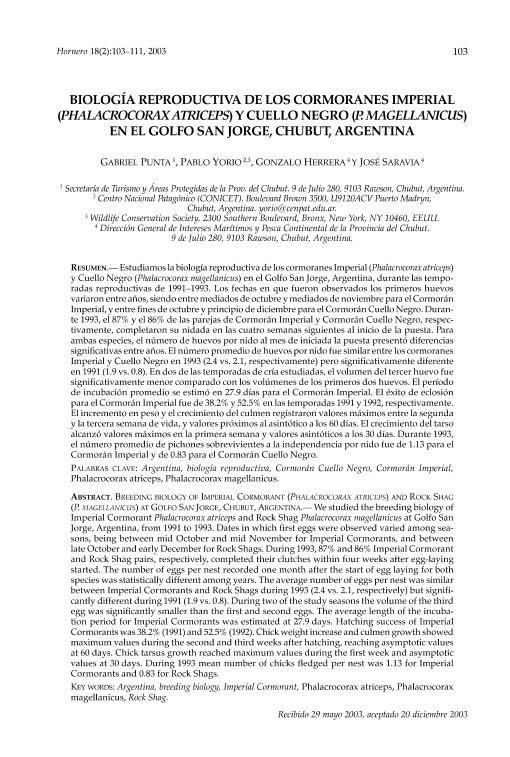Mostrar el registro sencillo del ítem
dc.contributor.author
Punta, Gabriel
dc.contributor.author
Yorio, Pablo Martin

dc.contributor.author
Herrera, Gonzalo Octavio

dc.contributor.author
Saravia, José Daniel

dc.date.available
2020-04-20T16:35:55Z
dc.date.issued
2003-12
dc.identifier.citation
Punta, Gabriel; Yorio, Pablo Martin; Herrera, Gonzalo Octavio; Saravia, José Daniel; Biología reproductiva de los cormoranes Imperial (Phalacrocorax atriceps) y Cuello Negro (P. magellanicus) en el Golfo San Jorge, Chubut, Argentina; Aves Argentinas; El Hornero; 18; 2; 12-2003; 103-111
dc.identifier.issn
0073-3407
dc.identifier.uri
http://hdl.handle.net/11336/103043
dc.description.abstract
Estudiamos la biología reproductiva de los cormoranes Imperial Phalacrocorax atriceps y Cuello Negro P. magellanicus en el Golfo San Jorge, Argentina, durante las temporadas reproductivas de 1991 a 1993. Los fechas en que fueron observados los primeros huevos variaron entre años, siendo entre mediados de octubre y mediados de noviembre para el Cormorán Imperial, y entre fines de octubre y principio de diciembre para el Cormorán Cuello Negro. Durante 1993, el 87 y 86% de las parejas de Cormorán Imperial y Cormorán Cuello Negro, respectivamente, completaron su nidada en las cuatro semanas siguientes al inicio de la puesta. Para ambas especies, el número de huevos por nido al mes de iniciada la puesta presentó diferencias significativas entre años. El número de huevos por nido fue similar entre los cormoranes Imperial y Cuello Negro en 1993 (2,4 ± 0,8 vs. 2,1 ± 1,1, respectivamente) pero significativamente diferente en 1991 (1,9 ± 0,9 vs. 0,8 ± 0,9, respectivamente). En dos de las temporadas de cría estudiadas, el volumen del tercer huevo fue significativamente menor comparado con los volúmenes de los primeros dos huevos. El período de incubación se estimó en 27,9 ± 2,4 días para el Cormorán Imperial y en 26,7 ± 0,7 días para el Cormorán Cuello Negro. El éxito de eclosión para el Cormorán Imperial fue del 38,2 y 52,5% en las temporadas 1991 y 1992, respectivamente. El incremento en peso y el crecimiento del culmen registraron valores máximos entre la segunda y tercer semana de vida, y valores próximos al asintótico a los 60 días. El crecimiento del tarso alcanzó valores máximos en la primer semana y valores asintóticos a los 30 días. Durante 1993, el número medio de pichones sobrevivientes a la independencia por nido fue de 1,13 para el Cormorán Imperial y 0,83 para el Cormorán Cuello Negro.
dc.description.abstract
Breeding biology op imperial cormorant (phalacrocorax atriceps) and rock shag (p. Magellanicus) at golfo san jorge, chubut, argentina. We studied the breeding biology of Imperial Cormorant Phalacrocorax atríceps and Rock Shag Phalacrocorax magellanícus at Golfo San Jorge, Argentina, from 1991 to 1993. Dates in which first eggs were observed varied among seasons, being between mid October and mid November for Imperial Cormorants, and between late October and early December for Rock Shags. During 1993, 87% and 86% Imperial Cormorant and Rock Shag pairs, respectively, completed their clutches within four weeks after egg-laying started. The number of eggs per nest recorded one month after the start of egg laying for both species was statistically different among years. The average number of eggs per nest was similar between Imperial Cormorants and Rock Shags during 1993 (2.4 vs. 2.1, respectively) but significantly different during 1991 (1.9 vs. 0.8). During two of the study seasons the volume of the third egg was significantly smaller than the first and second eggs. The average length of the incubation period for Imperial Cormorants was estimated at 27.9 days. Hatching success of Imperial Cormorants was 38.2% (1991) and 52.5% (1992). Chick weight increase and culmen growth showed maximum values during the second and third weeks after hatching, reaching asymptotic values at 60 days. Chick tarsus growth reached maximum values during the first week and asymptotic values at 30 days. During 1993 mean number of chicks fledged per nest was 1.13 for Imperial Cormorants and 0.83 for Rock Shags.
dc.format
application/pdf
dc.language.iso
spa
dc.publisher
Aves Argentinas
dc.rights
info:eu-repo/semantics/openAccess
dc.rights.uri
https://creativecommons.org/licenses/by-nc-sa/2.5/ar/
dc.subject
ARGENTINA
dc.subject
BREEDÍNG BÍOLOGI
dc.subject
IMPERIAL CORMORANT
dc.subject
PHALACROCORAX ATRICEPS
dc.subject
PHALACROCORAX MAGELLANICUS
dc.subject
ROCK SHAG
dc.subject.classification
Ecología

dc.subject.classification
Ciencias Biológicas

dc.subject.classification
CIENCIAS NATURALES Y EXACTAS

dc.title
Biología reproductiva de los cormoranes Imperial (Phalacrocorax atriceps) y Cuello Negro (P. magellanicus) en el Golfo San Jorge, Chubut, Argentina
dc.type
info:eu-repo/semantics/article
dc.type
info:ar-repo/semantics/artículo
dc.type
info:eu-repo/semantics/publishedVersion
dc.date.updated
2020-04-06T16:09:11Z
dc.journal.volume
18
dc.journal.number
2
dc.journal.pagination
103-111
dc.journal.pais
Argentina

dc.description.fil
Fil: Punta, Gabriel. Gobierno de la Provincia del Chubut. Ministerio de Turismo. Subsecretaria de Conservacion y Areas Protegidas.; Argentina
dc.description.fil
Fil: Yorio, Pablo Martin. Wildlife Conservation Society; Estados Unidos. Consejo Nacional de Investigaciones Científicas y Técnicas. Centro Científico Tecnológico Conicet - Centro Nacional Patagónico; Argentina
dc.description.fil
Fil: Herrera, Gonzalo Octavio. Gobierno de la Provincia del Chubut. Dirección General de Intereses Marítimos y Pesca Continental; Argentina
dc.description.fil
Fil: Saravia, José Daniel. Gobierno de la Provincia del Chubut. Dirección General de Intereses Marítimos y Pesca Continental; Argentina
dc.journal.title
El Hornero

dc.relation.alternativeid
info:eu-repo/semantics/altIdentifier/url/https://www.avesargentinas.org.ar/el-hornero
dc.relation.alternativeid
info:eu-repo/semantics/altIdentifier/url/http://www.scielo.org.ar/pdf/hornero/v18n2/v18n2a04.pdf
Archivos asociados
